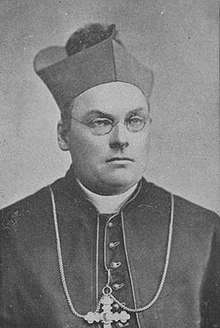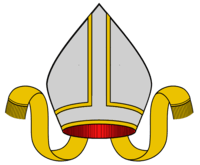Henry Henry
Henry Henry (22 May 1846 - 8 March 1908) was an Irish Roman Catholic Prelate and from 1895 until 1908 he held the title Lord Bishop of Down and Connor. He was known for his energy and zeal, as well as his overt activism in local politics, founding the 'Belfast Catholic Association'.
The Most Reverend Henry Henry | |
|---|---|
| Bishop of Down and Connor | |
 | |
| Church | Catholic Church |
| Archdiocese | Archdiocese of Armagh |
| Diocese | Diocese of Down and Connor |
| In office | 1895–1908 |
| Predecessor | Patrick MacAlister |
| Successor | John Tohill |
| Orders | |
| Ordination | 7 June 1870 |
| Consecration | 22 Sept 1895 by Michael Logue |
| Personal details | |
| Born | 22 May 1846 Loughguile |
| Died | 8 March 1908 Belfast |
| Previous post | President St. Malachy's College |
| Styles of Henry Henry | |
|---|---|
 | |
| Reference style | The Most Reverend |
| Spoken style | Your Lordship or Bishop |
| Religious style | Bishop |
| Posthumous style | not applicable |
Education and priestly ministry
Henry was born in Loughguile, County Antrim. After his education at St Patrick's College, Maynooth, he was ordained for the Diocese of Down and Connor on 7 June 1870 by Matthew Quinn, the Bishop of Bathurst. The Diocese of Bathurst is located in New South Wales in Australia.
He was appointed to St. Malachy's Diocesan College to teach French and Mathematics. He succeeded Marner as President of the College from 1876–95, before his Episcopal nomination; he is, to date, the longest serving president of the college.
Bishop
He was appointed 25th Bishop of Down and Connor on 6 August 1895 and was consecrated bishop in St Patrick's Church, Belfast on 22 Sept 1895 by Cardinal Logue. One of his first acts was to agree to be patron of the nascent Gaelic League in Belfast.[1] The distinguished Jesuit historian, Fr Oliver P. Rafferty calls Henry Henry "a man of decidedly theocratic tastes" and assesses many of his decisions, especially those relating to politics and civil society as "quixotic." [2]
Dr Henry believed that a religious order of priests could give invaluable help in the densely populated area of West Belfast. Accordingly he invited the Redemptorists to found a community there at Clonard Monastery. It was a welcome invitation, which they accepted as they were already looking for a foundation in the North.
In 1900, he helped establish St. Mary's Training College to staff local Catholic schools. [3]
Belfast Catholic Association
In 1896, Bishop Henry organised a Catholic Association, initially confined to controlling representation in the newly created Catholic wards [of Belfast]. It dominated municipal politics in West Belfast for a decade: it easily defeated the Nationalist slate of candidates in the two wards in 1897 and 1904, and between these dates its candidates were not even challenged. Its viewpoint dominated the Irish News, the local Catholic newspaper, to such an extent that the Irish Nationalist leader in the city, Joseph Devlin, had to begin a rival, the Northern Star, in 1897.[4]
Henry's episcopal ministry took place against the intensely fought political battles around Irish Home Rule and he worked hard to influence nationalist political opinion, and representation in Belfast, at the heart of his diocese. By 1912, however, Devlin had won control of nationalist thought in the city.[5]
References
- McMahon, Timothy G. (2008). Grand Opportunity: The Gaelic Revival and Irish Society, 1893-1910. Syracuse University Press. ISBN 9780815631842.
- "Catholicism Ulster 1603 1983 Interpretative by Oliver Rafferty - AbeBooks". www.abebooks.co.uk. Retrieved 22 March 2018.
- http://www.downandconnor.org/blog/2018/03/29/29-march-2018-homily-bishop-treanor-chrism-mass/
- A past apart: studies in the history of Catholic Belfast, 1850-1950, Anthony C. Hepburn, Ulster Historical Foundation (1996), 261 pages (ISBN 0901905720)
- "Perspective On The Ulster Covenant Lecture Notes". www.niassembly.gov.uk. Retrieved 22 March 2018.
External links
- Catholic Hierarchy.org [self-published]